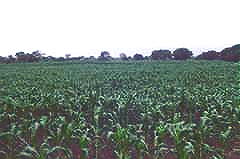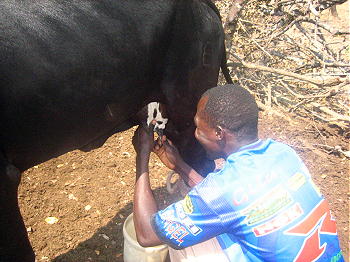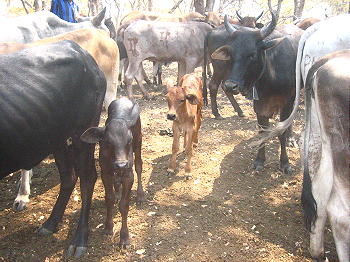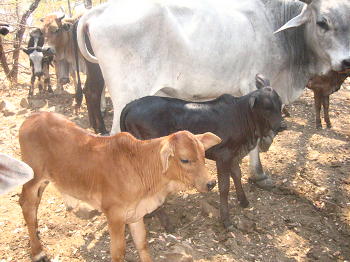LifeNets Zambia Annual Report
Year Ending December 31, 2009
by Kambani Banda
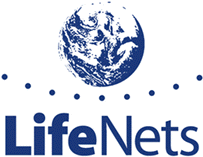 Posted
February 16, 2010
Posted
February 16, 2010
Introduction
The year 2009 is behind now behind us. It is, once again, time to stop and take stock of what we have done during this last year and look to see what we need to do for the year ending December 31, 2010.
Cattle Restoration Project
The cattle restoration project continues to be the most important work that we do in Zambia.
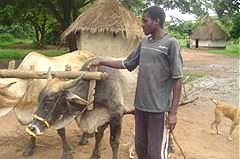 The
oxen are now fully grown. Farmers now yoke them in pairs, rather than in
fours as can be seen from the picture on the right. More work is done
because while one pair of oxen is working, the other pair can graze. In
the afternoon, the pair that was grazing in the morning is yoked while
the pair that was working in the morning can graze.
The
oxen are now fully grown. Farmers now yoke them in pairs, rather than in
fours as can be seen from the picture on the right. More work is done
because while one pair of oxen is working, the other pair can graze. In
the afternoon, the pair that was grazing in the morning is yoked while
the pair that was working in the morning can graze.
This way, the health of the oxen is not compromised, even though more work is done. The huts in the background are the farmers’ dwelling quarters.
Although we are making
progress, there is still much more that needs to be done if we are to
bring these people living standards even remotely close to that of the
poorest of the poor in the developed economies.
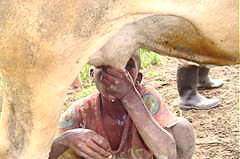 The
heifers continue to provide milk for our farmers and their families.
Milk is the most readily available source of protein. As the picture on
the left
illustrates, this young boy is drinking milk straight from a heifer
after his father (who is the gentleman wearing gum boots behind the heifer) has
finished milking. Hygiene is the last thing on
the boys mind, as in his view, nothing can be fresher than milk straight
from the cow!
The
heifers continue to provide milk for our farmers and their families.
Milk is the most readily available source of protein. As the picture on
the left
illustrates, this young boy is drinking milk straight from a heifer
after his father (who is the gentleman wearing gum boots behind the heifer) has
finished milking. Hygiene is the last thing on
the boys mind, as in his view, nothing can be fresher than milk straight
from the cow!
The farmers sell excess milk to buy basic necessities like salt, candles, cooking oil sugar, school exercise books, pencils etc.
From the original heifers, two died during the year under review. The cause of death was natural wastage and aging. The original herd is almost eleven years and I understand that the life expectancy of a heifer is 14 years.
 The
original heifers dropped eight calves. This is an 80 % calving rate. The
calving rate in the phase one heifers is an indication that these
heifers have recovered from the Lumpy Skin Disease of three years ago.
The Phase Two heifers dropped nine calves. The 50% calving rate is
acceptable because they are still young. Again there was no disease
outbreak in the year ending 31 December 2009.
The
original heifers dropped eight calves. This is an 80 % calving rate. The
calving rate in the phase one heifers is an indication that these
heifers have recovered from the Lumpy Skin Disease of three years ago.
The Phase Two heifers dropped nine calves. The 50% calving rate is
acceptable because they are still young. Again there was no disease
outbreak in the year ending 31 December 2009.
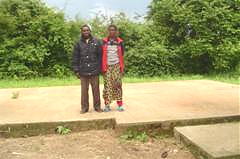 Our
participating farmers sold ten animals to meet various family needs,
mainly school fees and other capital expenditure projects like the slab
that was cast for a new brick house under construction in the picture on
the left.
Our
participating farmers sold ten animals to meet various family needs,
mainly school fees and other capital expenditure projects like the slab
that was cast for a new brick house under construction in the picture on
the left.
Lloyd and Jerry lost 14 and 11 animals respectively through theft. Out of the animals that were stolen, three belonged to our project. This is a new and sad development in this area. The good news though is that some of the cattle rustlers were caught and they are now in police custody awaiting trial. The animals have not been recovered to date.
The animal herd now stands at 95, (105 in 2009) and this is valued at K 95 Million Kwacha (105 Million in 2009). . This is equivalent to US$ 23,750. The US dollar is worth 4680 Zambian Kwachas. This is a marked increase from the US $4000 that was invested in 2001. This number excludes the 13 animals that were sold and stolen.
We are pleased to report that for the first time in the history of the project, we received two calves as tithes from this project. We projected that we would receive four in our last report but we are down by two; none the less, this is an exciting new phase to our project.
Overall the herd is in good shape.
Farm credit program
This is the second most important service that we provide to this community. During the year under review, the one farmer that defaulted on his loan repaid the balance on his account, therefore, we admitted him back on to the program. This is very exciting because it indicates that behavioral change could very well be taking place. Such changes are in our view, the heart and soul of this program. Our aim is for members to understand that no meaningful economic progress can be made unless and until they remain true to their commitments.
|
|
|
The total amount advanced for inputs in the year ending 2009 was K16 Million. What this investment does is self evident. The field on the left (picture above) was planted on the same day as the field on the right. In the field on the left, the farmer used certified seed and applied fertilizer. The second farmer (the farm pictured on the right) did not use certified seed and did not apply fertilizer. The difference is self evident.
The farming season 2008/9 was the best season in living memory. The rains were normal (ending in late March.) Again our farmers (even those on the fringe), produced a very good crop.
With the bumper harvest which was the norm this season, maize floor prices collapsed. During a maize marketing season like this, the monetary advances we give our farmers are critical to the survival of their businesses.
The so-called “brief case business men” (as predicted), bought the maize for next to nothing. They are now selling this same maize at its regular price and laughing all the way to the bank.
Our farmers held on to their maize because we financed their living expenses. They have now sold their maize, making a healthy return on their investment. Having the opportunity to stop the exploitation of simple, but hard working people, gives meaning and purposes to our lives.
In the year under review, the following is what the agriculture credit program delivered:
1) We are now in the process of selling the maize collected as first and second tithe. We estimate that 1st tithes from this area will be not less than K9.500 Million. Compared to the K7.720 Million in 2008, this is a projected increase of 23%. According to the Government figures, inflation for the year ending 31 12 09 was 15%. This means that there is an 8% growth in the incomes of our members.
2) All the
households paid their tithes
3) Three families requested assistance; two families are those that we help every year. The reason that an additional family needed assistance was due to bad financial planning, rather than a lack of means.
Out Look – 2009/10 Farming Season
The 2009/10 season is not normal; the rains started in the middle of November, which is normal but they were very heavy. This made the soil very wet during planting. For farmers that used a harrow to loosen the soil, germination was extremely good. But for the farmers that did not use a harrow, the heavy rains compacted the soil, and as a result, germination was very poor.
After about ten days, rains stopped for about a month. After the rain stopped, it became extremely hot; the soils soon dried up making it impossible for farmers to plant. When the rain returned in early January, it was then too late to plant.
We speculate that a large number of households that did not plant early will suffer a food shortfall in the coming year. We have inspected the crops of our participating farmers and these are looking extremely good. Our farmers now see for themselves, the value of early planting.
 Although most of the
maize wilted due to intense heat, the certified seed used by our
farmers has the capacity to withstand prolonged period of drought.
This will make a big difference to the yield that our farmers will
get. The rains have now returned and the crop looks like great. The
picture taken two weeks ago is a good representation of our farmer’s
crop this season.
Although most of the
maize wilted due to intense heat, the certified seed used by our
farmers has the capacity to withstand prolonged period of drought.
This will make a big difference to the yield that our farmers will
get. The rains have now returned and the crop looks like great. The
picture taken two weeks ago is a good representation of our farmer’s
crop this season.
Changes to the Government Agricultural Support Policy
During the year, the government made a major revision to its Agricultural Support Program. They reduced the planting pack size given to each family by 50 % and increased the number of farmers entitled to this facility by100%.
The number of civil servants administering this scheme remained the same. The fact that farmers receiving government support doubled and the staff administering this program remained the same meant that there were long lines at the fertilizer collecting depots.
Farmers lost valuable time queuing in line to collect 4 bags of fertilizer and 10Kgs of seed.
There were unexplained delays and rampant corruption during the allocation of agriculture inputs. Considering that 14 November – 15 December is the small window of opportunity during which maize seed must be planted; farmers cannot afford to waste such valuable time.
Unfortunately, with the decease of late president Mwanawasa, we are beginning to witness the corruption in the Civil Service reminiscent of the previous administration.
This development derailed our farmers work plan. To prevent the total collapse of our farm credit program, we funded the 50% short fall by sourcing fertilizers from the open market. The open market price of farm inputs is 75% more expensive than the Government subsidized packs. We attach a letter from the Government outlining this new policy.
Even with the increase in the farming inputs, our farmers will still make money because they will wait to sell their crop until the price is good. The fact that our farmers can source seed and fertilizer from the open market and still make money, in our view, is a step in the right direction.
It forces them to operate their businesses in the way that other Zambian commercial farmers do – that is, they no longer need to rely on an inefficient, corrupt system to earn a living.
Farm mechanization
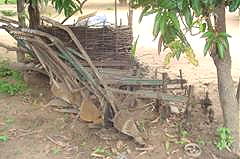 Most
of the families now own at least a plow, and most own an ox drawn
harrow. We planned that Jerry Shachoongo buy a planter so that we
can demonstrate to the other farmers the power of technology.
Most
of the families now own at least a plow, and most own an ox drawn
harrow. We planned that Jerry Shachoongo buy a planter so that we
can demonstrate to the other farmers the power of technology.
Because Jerry bought most of his fertilizer on the open market, he
decided to delay this "huge” capital expenditure and instead used
funds from the farm mechanization facility to finance the additional
working capital required by his business. He plans to buy the
planter in the next season.
During the year, we plan to buy a Maize Sheller for Nalubanda and Kasumpa farmers. This machine will help farmers shell their maize quickly. Life Nets (Australia) provided the funds for this project.
Medical
While we aim to help people help themselves, we realize that there are areas where this is not possible. If the government cannot supply simple medication for Malaria, there is no way a simple farmer can.
This is why we regard the medical support aspect of our work as critically important. Because of the simple drugs and vitamins we supply, for the 8th straight year running, no deaths were recorded within our community.
The medicine required
by our farmers has reduced, and the 2008 consignment lasted until
October 2009. The reduction in consumption is mainly due to the fact
that the general health of the farmers and their families has
improved considerably in the ten years we have worked in their area.
The fact that we are less dependant on LifeNets medical aid, is
testimony, that our
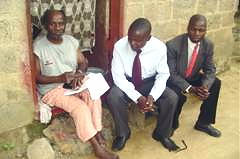 intervention
measures are working.
intervention
measures are working.
During the year, we came in contact with Mr. Horasi Siyono Kayombo (on the extreme left in the picture on left) This man lost contact with the Church during the upheavals of the 1990s. By chance he made contact with the church.
But unfortunately, during the time he lost contact with us, he suffered a stroke that left his left leg paralyzed. We request that you fund a wheel chair to help him. The cost of the wheel Chair is K2,000 and we have included this in the budget.
We are happy to
report that the wheel chair we bought for Mary of Mapoko is still in
good working order.
Wells
Out of the three wells we dug in Nalubanda, the two wells located at Apren’s and Jerry’s properties still continue to provide pure, clean and safe drinking to our church members, the local community and their live stock.
The Mitsubishi
Canter is running well. This vehicle is so valuable that I wonder
how we can run our Life Nets programs and the church in Zambia. The
picture below is both tribute to both the value of this vehicle and
the power of the OX.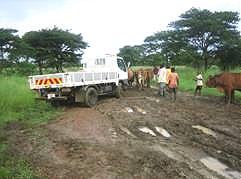
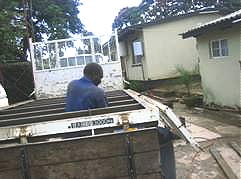
During the year under review the timber in the trailer was removed and replaced with metal. The picture on the right shows an artisan welding the metal on to the trailer of the vehicle. Since this was done, we have not experienced any problem with this vehicle during the year.
Management
Haben Moonga
continues as our man in Mumbwa so does Ephraim Mwashi in Mapoko.
Again I wish to show appreciation to these men by helping them to repair the bicycles that they use to over sea the projects in their respective areas. I have included K0.600 Million in the budget.
Jerry and his wife Nice have been again very helpful to me. Without their on spot involvement with this project, we would not be able to choke the successes that we now report.
Scholarships
 Bevin
has finished his Diploma program in insurance. To our great relief
he has found a job with Diamond Insurance. We are very excited that
Bevin is settling down well in the Lusaka Church.
Bevin
has finished his Diploma program in insurance. To our great relief
he has found a job with Diamond Insurance. We are very excited that
Bevin is settling down well in the Lusaka Church.
He assists in song leading and with the Youth Club activities. We are also pleased that he contributes to the finances of the church by paying tithes. This is a testimony to the effectiveness of this program
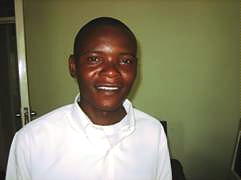 Sylvester Njovu
(right)
completed his Higher National Diploma in IT and we recommend that he
goes to college for a further year so that he can obtain a degree in
IT. Sylvester is another young man that promises to be a good asset
to the church in Lusaka. Both Bevin and Sylvester serve as important
role models to our young men and women in our Lusaka church who
together number nineteen.
Sylvester Njovu
(right)
completed his Higher National Diploma in IT and we recommend that he
goes to college for a further year so that he can obtain a degree in
IT. Sylvester is another young man that promises to be a good asset
to the church in Lusaka. Both Bevin and Sylvester serve as important
role models to our young men and women in our Lusaka church who
together number nineteen.
Zere Phiri (on the right in the photos below) is now doing her second semester of the second year at the University of Zambia. We have very high hopes for this young lady and believe that the investment that we make in her will greatly benefit the Church not too long from now.
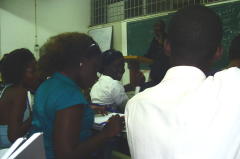
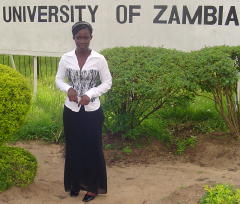
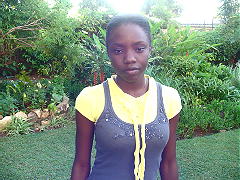 We propose to add
Abigail Mfula (pictured on the right) to our portfolio of students.
Abigail was recently admitted to Mulungushi University in Kabwe, a
town 140 Kilometers north of Lusaka. This young lady has grown up in
the church, and her behavior, thus far, is impressive.
We propose to add
Abigail Mfula (pictured on the right) to our portfolio of students.
Abigail was recently admitted to Mulungushi University in Kabwe, a
town 140 Kilometers north of Lusaka. This young lady has grown up in
the church, and her behavior, thus far, is impressive.
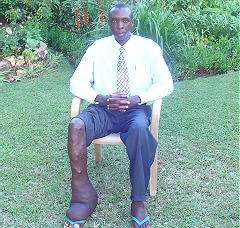
We also propose to add Sydney Talama to our scholarship program. This young man is remarkable. He is disabled. But, and in spite of this handicap, he managed to gain admission into the university. His condition (elephantitis) attracts a mixture of stigma and sympathy in Zambia. That notwithstanding, he managed to gain admission into university which is quite a feat in itself due to the limited university places in Zambia.
We have requested funding for all the above students.
This program is slow to yield results but it is our vision that it will be the one program that will bring great benefits.
Maize Marketing
 With the additional
funding received during this last budget year (and the success of
this project), we added eight more families to
this
project. The profit margin remained between 55% - 60 %.
With the additional
funding received during this last budget year (and the success of
this project), we added eight more families to
this
project. The profit margin remained between 55% - 60 %.
The picture on the left shows our Mitsubishi Canter the truck taking maize to the millers is January 20, 2010. The total investment in this venture is K 25,000 million.
LifeNets in Mapoko
This is the third year that we have worked in the Mapoko region.
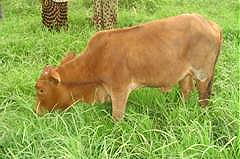 Cattle
Restoration project
Cattle
Restoration project
During the year under review the mortality was one. Our only bull in Mapoko died after it was beaten by a swarm of horse flies. We had no choice but to replace this bull if the program was to continue. Three calves were born during the year under review, and one of them is pictured below. We look forward to an improved calving rate as the heifers mature.
The total herd in Mapoko is 27, and all the animals are in good health.
Farm Credit Program
For the third year running, all the families that benefited from this program have repaid their loans. During this season, we have invested K30 Million in this project
Maize production in Mapoko reached an all time high. Tithes for Mapoko increased from K1.020 Million in the year ending 31 12 08 to K2.100 million for the year ending 31 12 09. This is a 105% increase in the income of the members and the church.
There is no need to comment on the operation of this project. The figures speak for themselves.
Mechanization
All the families in Mapoko now own a plough and nearly all of them own an ox drawn harrow. During the year under review, we made a huge investment in this project. We bought a Maize Sheller (shown in the Picture below) which was financed by LifeNets Australia.
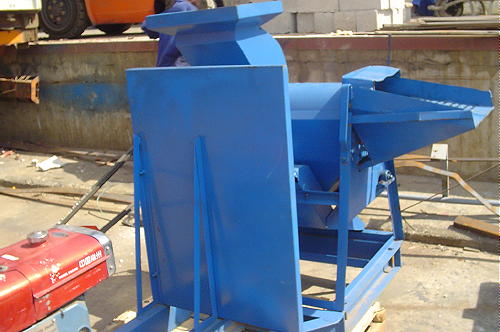
Budget and Financial Statements and Budget
We attach the Financial Statements for the year ending 31 December, 2009 and a budget for the period to 31 December, 2010 amounting to US $18,300.
The salient features of the budget for 12 Months, ending 31 December, 2010 are as follows:
US$
Scholarships 8,000
Vehicle Insurance 950
Farm Credit Revolving Fund 6,000
Local Operating Expenses 3,350
Total 18,300
Conclusion
With your support, we look to the coming year with a great deal of excitement.
________________
Mid-year Report sent earlier as of June 30, 2009
I thought I could do a short write up to let you know where we as regards the work we do in Zambia
Cattle Restoration Project
The good news is that we have two new calves born at Mapoko. It took along time to get to where we are today; how ever, we take consolation at the fact that we are now beginning to see a return on our investment.
Farm Credit Program
The 2008/2009 season, country wide; as we predicted, proved to be the best in living memory. The story is no different for families that participate in LifeNets Farm Credit Program. We do not have yield figures yet, but, by all accounts, we hope to post the best result ever.
Again, we do not for see any family defaulting on their loans this season.
The maize price, in
spite of the bumper harvest, is already at K 130,000 per 100 Kg. The
above price is surprisingly good for this time of the year. The
attractive producer price reflects the grain shortage in the Central
and East Africa due to wars raging in the great lakes region and the
continuing problems in Zimbabwe. It is sad that one section of
society can receive a wind fall gain at the expense of neighboring
countries’ problems, but, that is the reality in this world.
Maize Marketing
Program
We have expanded this program to include additional families from the Copper belt and Mapoko. The amount of loans advanced to participating families increased from 1.0 Million to K 2.200 Million. The projected profit margin on this business will be around 100% and the lead time will reduce from six to three months.
Medical
We regret to report that, after a long battle with Cancer, Mundongo Chisangu finally succumbed and died in March 2009. LifeNets paid for Chisangu’s medical bills when he under went chemotherapy at the University Teaching Hospital in Lusaka.
Llyod, the other man that under went two surgical Operations in Lusaka at LifeNets expense, is much better. A little pass is still oozes from his wound. He appears to have resigned to the fact that he may have to live with this wound for the foreseeable future
We plan to place the medicine order shortly.
The Photos are from September 2009 -- more story after the Photos.
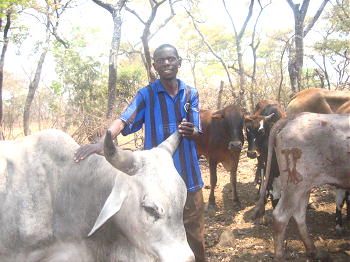 Clever Hamuchindu showing off heifer
Women bagging maize
Milking a heifer
One of the oxen given to the Mapoko farmers |
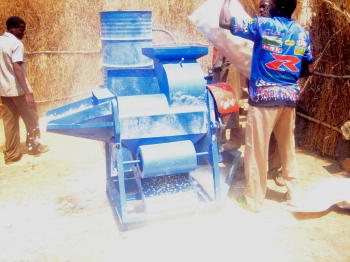 Redson feeding the maize sheller
The Sheller arrives
The Mapoko Herd
Two of three of the calves born from Mapoko heifers |
Wells
The well at the Lusaka Festival site is situated near the hall is working and the water level is only two meters from the surface. It has served us well during all the Holydays, United Youth Camp and the English class that just finished. The well is indeed a great blessing. Unfortunately, the well on the western side of our site collapsed.
In June 2009, we dug two wells using a drilling rig and we plan to equip them with submersible pumps. It follows, therefore, that the do not need the pump that is installed in the well on the western side of our property – the well that collapsed.
As you may be aware, at Mapoko, we camp around the church premises during the Annual Holydays. When we camp at this site, we draw water from a school situated about 1.5 Kilometers away. Ironically, rolling drums to the borehole is easy, because the well is down hill. Coming back however is a different story; the drums are full of water, and the church is up hill. It does not take a lot of imagination to realize that it takes a lot of sweat to roll the drum up hill to the church site; on the Sabbath and a High Day at that.
It is for this reason that we wish to dig a well at the Mapoko Church Site. The well, if done, will supply water to use during the church functions.
Electricity Supply at the Lusaka Feast Site
The Zambia Electricity Supply Corporation (Zesco), the Power Company in Zambia completed a survey to determine what materials they need procured and what works need to be done before they connect power to our property from the National Grid. They came up with a quotation in June 09 of US$10, 000 in round sums. We are glad to report that we have paid this sum from funds that you gave to us.
The Power Company promise they will start work on our property in the first week of August and should complete and the property energized before the end of the same August 2009.
Scholarships
Bevin has completed his Diploma in Insurance. He is having a difficult time finding a job (he consequently DID find a good job that is spoken in the later edition of the 2009 report). We keep him at the house. Of late, he looks discouraged in spite of our effort to reassure him that even this trail will pass. Please think about him.
Sylvester should complete his Computer Studies Diploma in December 2009. If he passes, which we think he will, we recommend that he studies for one more year. If he does pass the examination at the end of the year, the college will award him a Degree. This strategy will greatly improve his chances of getting a job.
Zere has finished her first year at the university of Zambia. We attach her results. As the results show, she has done very well. Further she sets a very good example to her peers at church. We think she promises to deliver great things for the church and herself. She began the first semester of her second year in July 2009.
